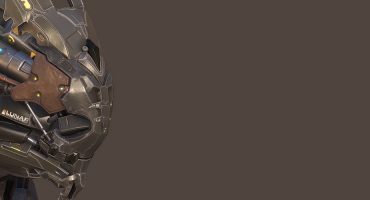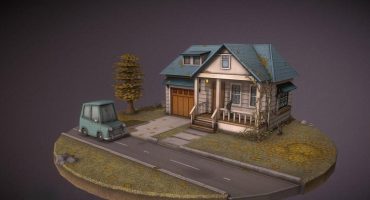Hello! My name is Gregory and I am a biologist from Russia. I like the idea of project presentation in the way that Sketchfab allows. It allows you to find a huge number of biological models, scanned museum exhibits and other things.
But today I want to talk about something else. Here is “Sør-Helgeland” by Kristofer Haugvik.
Stunning simplicity and minimalism reflects the stark beauty of Norway: the sea, the rocks and the sky. I love it so much!
So, I had an idea:
– to give his pictures a depth (the third dimension)
– but, to make it so that the transition from 2D to 3D looks like a surprise, to fool the brain, to break the picture that the brain has managed to build, on the basis of the initial point of view.
I think it was also influenced by the game the Witness, which I played at the same time. This game has a HUGE amount of illusions and puzzles associated with parallax. Try googling something like “the witness environmental puzzles”. 🙂
Recently I made a series of minimalistic scenes, based on Kristofer’s project. It was a very interesting and exciting project for me:
Parallax by Gregory Khodyrev on Sketchfab
Unexpectedly, they aroused great interest in the community. Now I will tell you a little about the process of their creation.
Modeling in Blender
First I downloaded the reference image and dragged this file into the Blender window – the background image now appeared. Then I modeled very simple objects in the orthographic projection.
Then I added a hole and a frame to the wall in the foreground. The frame is slightly away from the wall for a floating effect.
The backgrounds (ground, sea, sky), as you can see, have different profiles in all cases:
For example, in the scene “Norway” the flat surface looked dull and I made it convex, a bit like a hillside. In the “Sunset” scene, I wanted to create a reflection effect and avoid intersecting the background plane with the sun’s reflection (which is just a cylinder), so I had to rotate the background at an angle from the viewer.
All this is not readable on a flat picture initially, so when the viewer moves the camera, a small surprise awaits him. I think that this adds attraction and depth to the scene.
Use the Model Inspector function to view more details 🙂
Materials
There are no textures here. I decided to separate faces with the same color and assign one material to them. Some faces were deleted, so that the background with the required color was visible.
After uploading the scene to Sketchfab, I assigned colors to each material: I copied the HEX code from Blender and pasted it into the diffuse color in Sketchfab.
Easy! What could possibly go wrong?!
But, in the “Seashore” final scene, for example, there are 35 materials on Sketchfab and approximately 50 in Blender … not so minimalistic. 🙂
Initially, for the foreground I wanted to make a real shadow from the frame, using several light sources and bake it into a texture. But it was much faster to make a texture in Photoshop, using gradient fill and the “Shadow” effect. The texture file was saved as a PDF, so I could change the color of the wall without having to re-do it every time.
In the “Sunset” scene I flipped normals for the sun. As you can see, the sun is two spheres (roundcubes), one inside the other. One of them has a white color, and the other is yellow. We need to see the little one through the bigger one from any camera position. That’s where the flipping normals and one sided shading (for the bigger yellow sphere) should help us: now we see back faces and front faces are invisible to us. I also turned on the “Single sided” option in the “Faces render” part of material settings on Sketchfab. The same trick works for reflection (multiple cylinders, one in another).
Just look at how it’s done:
And the result that we get:
Sketchfab 3D settings
The main goal for settings here was to preserve the illusion of a 3D picture on the wall.
Shading – Shadeless
Background type – Color
Post processing filters – Sharpness (10-15%)
FOV close to orthographic (5 – 10)
Focus point* – you should set it for smooth believable movement of camera and to show the scale of the scene

Limit orbit camera* – set it to avoid letting the viewer see excess parts of the scene (for example, the edge of the front wall or long flat boring seashore). Don’t ruin the illusion!
* – this setting is for PRO accounts only.
In conclusion, I need to say that I had to re-upload all of my scenes about a dozen times or more to fix all the little things. It is a kind of iterative process. Do not give up if something does not work out the first time. Try to get the best from your scenes.
That’s all, thank you for reading!











